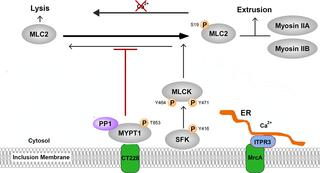PLoS Pathogens ( IF 5.5 ) Pub Date : 2018-03-15 , DOI: 10.1371/journal.ppat.1006911 Phu Hai Nguyen 1 , Erika I Lutter 1, 2 , Ted Hackstadt 1

|
Chlamydia trachomatis is an obligate intracellular bacterium that replicates within a vacuole termed an inclusion. At the end of their intracellular developmental cycle, chlamydiae are released either by lysis of the host cell or extrusion of the intact inclusion. The inclusion membrane is extensively modified by the insertion of type III secreted inclusion membrane proteins, Incs, which contribute to inclusion membrane structure and facilitate host-pathogen interactions. An interaction was identified between the inclusion membrane protein, MrcA, and the Ca2+ channel inositol-1,4,5-trisphosphate receptor, type 3 (ITPR3). ITPR3 was recruited and localized to active Src-family-kinase rich microdomains on the inclusion membrane as was the Ca2+ sensor, STIM1. Disruption of MrcA by directed mutagenesis resulted in loss of ITPR3 recruitment and simultaneous reduction of chlamydial release by extrusion. Complementation of MrcA restored ITPR3 recruitment and extrusion. Inhibition of extrusion was also observed following siRNA depletion of host ITPR3 or STIM1. Chlamydial extrusion was also inhibited by the calcium chelator BAPTA-AM. Each of these treatments resulted in a concomitant reduction in phosphorylation of the myosin regulatory light chain (MLC2) and a loss of myosin motor activity at the end of the developmental cycle which is consistent with the reduced extrusion formation. These studies suggest that Ca2+ signaling pathways play an important role in regulation of release mechanisms by C. trachomatis.
中文翻译:

沙眼衣原体包涵膜蛋白 MrcA 与 3 型肌醇 1,4,5-三磷酸受体 (ITPR3) 相互作用调节挤出形成
沙眼衣原体是一种专性细胞内细菌,在称为包涵体的液泡内复制。在细胞内发育周期结束时,衣原体通过宿主细胞的裂解或完整内含物的挤出而释放。包涵膜通过插入 III 型分泌包涵膜蛋白 Incs 进行了广泛修饰,这有助于包涵膜结构并促进宿主与病原体的相互作用。包涵膜蛋白 MrcA 和 Ca 2+通道肌醇-1,4,5-三磷酸受体 3 型 (ITPR3)之间存在相互作用。ITPR3 被招募并定位到包涵体膜上富含活性 Src 家族激酶的微结构域,Ca 2+传感器 STIM1 也是如此。通过定向诱变破坏 MrcA 会导致 ITPR3 募集丧失,同时因挤出而导致衣原体释放减少。MrcA 的补充恢复了 ITPR3 的招募和挤出。siRNA 去除宿主 ITPR3 或 STIM1 后也观察到挤压抑制。钙螯合剂 BAPTA-AM 也能抑制衣原体的排出。这些处理中的每一种都会导致肌球蛋白调节轻链 (MLC2) 磷酸化的同时减少,以及发育周期结束时肌球蛋白运动活性的丧失,这与挤压形成的减少是一致的。这些研究表明Ca 2+信号通路在C释放机制的调节中发挥重要作用。沙眼衣原体。











































 京公网安备 11010802027423号
京公网安备 11010802027423号